#CSS tags and elements
Explore tagged Tumblr posts
Text
Advanced CSS Techniques and Best Practices - A Comprehensive Guide by WebTutor.dev

Cascading Style Sheets (CSS) plays a crucial role in web development, allowing developers to bring life and style to their web pages. If you are looking to take your CSS skills to the next level, you're in the right place! In this advanced blog post, we will delve into the world of CSS, focusing on the comprehensive guide provided by Webtutor.dev in their CSS Introduction tutorial. Get ready to enhance your CSS knowledge and discover advanced techniques and best practices.
Optimizing CSS Performance: Techniques and Tools
Efficient CSS code is essential for maintaining fast-loading web pages. We'll explore advanced techniques to optimize CSS performance, such as minimizing file size, reducing render-blocking CSS, and utilizing CSS preprocessors. The Webtutor.dev guide will provide insights into performance optimization strategies and recommend helpful tools.
CSS Layouts: Flexbox and Grid
Modern CSS layout techniques, namely Flexbox and Grid, have revolutionized web design. We'll dive deep into these powerful tools, exploring their features, properties, and best use cases. The Webtutor.dev guide will offer practical examples and tutorials to help you master the art of creating flexible and responsive layouts.
Advanced Selectors and Pseudo-classes
CSS selectors allow you to target specific elements on a web page. We'll go beyond the basics and explore advanced selectors, including attribute selectors, sibling combinators, and pseudo-classes. The blog will highlight real-world scenarios where these selectors shine, enabling you to create targeted and dynamic styles.
CSS Transitions and Animations
Adding subtle animations and transitions can greatly enhance the user experience. We'll delve into CSS transitions and animations, covering advanced techniques such as keyframes, timing functions, and complex animations. The Webtutor.dev guide will provide practical examples and tips for creating smooth and visually appealing animations.
Customizing and Styling Form Elements
Forms are an integral part of web applications, and customizing their appearance can greatly improve usability and aesthetics. We'll explore advanced techniques for styling form elements using CSS, including styling checkboxes, radio buttons, dropdowns, and input fields. The blog will showcase creative examples and provide guidance for cross-browser compatibility.
Responsive Design: Advanced Media Queries and Breakpoints
Responsive design is essential for creating websites that adapt to different screen sizes. We'll dive into advanced media queries and breakpoints, enabling you to design fluid and responsive layouts for a variety of devices. The Webtutor.dev guide will offer tips for managing complex layouts and provide examples of responsive design patterns.
Cross-browser Compatibility and CSS Prefixing
Ensuring consistent rendering across different web browsers can be a challenge. We'll discuss advanced techniques for achieving cross-browser compatibility, including CSS prefixing, vendor-specific properties, and polyfills. The blog will provide insights into browser support tables and strategies to handle browser-specific quirks.
Conclusion
As we conclude our exploration of advanced CSS techniques and best practices with the guidance of Webtutor.dev's CSS Introduction guide, you're now equipped with the knowledge to take your CSS skills to new heights. Remember to experiment, practice, and stay updated with emerging CSS trends and techniques. With the expertise gained from this comprehensive guide, you'll be able to create stunning, performant, and responsive web designs. Happy coding!
#Learn Code for Free#Learn CSS Online#Free Online CSS Tutorial#Css Online Tutorial#CSS Introduction tutorial#Advanced CSS Techniques#CSS trends and techniques#Learn CSS selectors#Learn CSS Layouts#Modern CSS layout#Learn CSS Prefixing#Styling Form Elements#CSS elements online tutorial#CSS elements tutorial for beginners#CSS elements for web developers#CSS tags and elements#Learn CSS elements#CSS elements for web development tutorial#Basic CSS elements#CSS elements for beginners#CSS elements for websites
1 note
·
View note
Text
Ublock Origin
Youtube: SponsorBlock (skips ads within videos), DeArrow (replaces clickbait thumbnails & titles), Blocktube (block channels), Enhancer (Quality of Life features), Youtube-Shorts Block
Youtube Mobile: Youtube Vanced/Revanced Manager
Twitter: Minimal Theme extension
Tumblr: xKit/xKit Rewritten, Dashboard Unfucker, Stylus with "Old Tumblr Dashboard" userstyle
Spotify: xManager (desktop & mobile)
Firefox: High chance you'll love it and curse holding out for so long.
Linux: No whiney search box trying to Edge you, no ads in the start menu, no trending searches reminding you about celebrity gossip & politics.
i would move heaven and earth to avoid hearing one single advertisement
#I'm not going to blindly tell you to “switch to Linux” but you can easily test it out in a Virtual Machine within windows.#There are guides online that will hold your hand through the setup process. Linux Mint is not scary. You might love it.#If setting up a VM still feels like too much? Then yeah stick with Windows. That's understandable.#but if you're reading this far then you must have caught on to how your ability to fight back is tied to your tech literacy skills#If you're already following workaround guides to forcibly disable Windows features that piss you off or install modified apks...#then you're halfway there#we all pick our battles & hills to die on though (My deepest condolences if you require Adobe for work 🥲)#There is also Ublocks 'element picker' but you can cause more confusion than good if#you don't know what you're doing (You can always remove filters)#Or do what uBlock picker does by learning a tiny bit of CSS and you can make anything you want on a website go bye-bye#pssst! ''display: none'' & ''visibility: hidden'' CSS declarations#I originally listed all this in the tags and realized it was a mess. May as well keep the tags now though:#Linux#Firefox#uBlock Origin#SponsorBlock#Youtube-Shorts Block#DeArrow#Youtube Vanced#ReVanced Manager#Revanced#Minimal Theme for Twitter#Stylus#xkit#xkit rewritten#Dashboard Unfucker#xManager#I spent my morning free-time on this 😪
58K notes
·
View notes
Text

im so good at this html shit. "just write a css file holy shit" no
#originals.txt#this is so cursed. i need to have the style tag taken away from me#all of the css is written in the head or in the individual elements i have a problem i have a severe problem
1 note
·
View note
Text
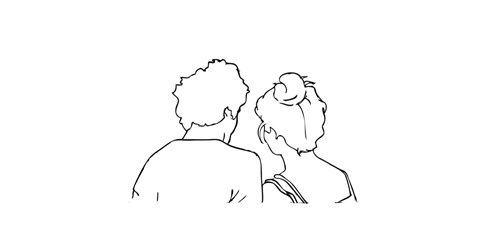
.。*♡゚ A/n: totally not trying to learn html (which technically isn't a programming language, for what I had read), and well, if Idia was teaching me I would learn everything so quickly tbh. Or not. He would start explaining and I would have the sudden urge to kiss him, oh well it happens ig

"Uh... I think I have an error in my code." You break the silence, tone soft as the computer screen lights up your eyes just the right way for Idia to lost himself in the reflex. He love your eyes, your concentrated face, the way you stick out your tongue without realizing.
And he loves the way you timidly look to him, as if he has all the answers to your questions - which, about this subject, he have, by the way.
"Ah~ your closing array is missing a closing slash. Here, Yuu-shi." He pointed your error with a soft tone, blue nail hitting the screen, and a surprised pout grew on your lips.
He wanted to smother you in his arms, to pick you up and hold you till his arms fell off and his corpse rot - that was how bad he yearned for you, your skin, you smell. He breathes really hard to refrain from doing it, though. You wouldn't want that. He was just a mere R card, a lonely gamer, a-
"Thank you, Idia. You're the best." You giggle to yourself, feeling yourself warm under his eyes and lousy smile. Unbeknownst to you, the only things that were going through his head were about you.
Your smile, the way your eyes lightened up, your laughters and giggles, the messages you passed each other in class (when he was there in person), your secret handshake. Idia loved you. He loved your very dearly.
He loved you so much that he could cry.
"Uh... it's no big deal," yet his hair was getting hotter, rosey tone starting to burn brightly. "Don't forget the closing stash, and everything should work properly. This programming language is not that used anymore, but most can learn useful things learning it anyway. I think."
Idia had half of his mind to know that he was rambling again, talking so fast that he could make Eminem cry. But he couldn't stop when you looked at him with such big eyes filled with curiosity and wonder, taking notes of everything he was saying.
He noted then that you had hello kitty stickers on your page. A few drawings that Ortho made of him, Idia and you; that almost killed him right then and there.
"Ah... HTML uses elements, tags, and attributes to organize text, images, links, and other multimedia elements. It can be combined with CSS for styling and JavaScript for interactivity."
#twst idia shroud#yandere idia shroud x reader#idia shroud x reader#idia shroud#idia x reader#idia x mc#yandere idia#twst idia#twisted wonderland idia#yandere idia x mc#yandere idia x reader#idia x yuu#idia x you#yandere idia x yuu#yandere idia shroud x yuu#yandere idia shroud x mc#yandere idia shroud
95 notes
·
View notes
Note
you were on cohost? i guess too late now, how was it for you?
cohost had its fair share of problems and i could often find the community there a bit too tumblr-core fingerwaggy if you know what i mean. but the site's dead now so it's kind of a moot point. what i find myself reflecting on most these days are the positives.
first, no numbers. i think their no numbers policy was probably a bit over-aggressive, but it quelled some of the rat race popularity contest aspect of social media that often makes it so tedious. i liked their tag tracking system, their robust content warning options, and the absence of infinite scroll. what i miss most about cohost is that their text editor supported CSS, which led to people programming elaborate text effects and puzzles and games in-site that harkened back to the days of flash animations. there was something in this combination of elements that drew out a rebellious creativity in users.
cohost came at a time when social media was across the board feeling terrible (and it's only gotten worse hahaha), particularly as someone who makes shit that relies on you clicking links that take you away from the website or app. algorithms hate this and punish it. users also just seem kind of lazy and disinterested in using the internet so much as letting the internet happen to them passively. but when a post of mine went viral on cohost, people engaged with it. it wasn't just likes and shares, it was comments and additions. it felt like a place that (at its best) encouraged actual conversation and the development of new ideas among like-minded peers. when my posts did well and i included a donation link, people gave me money. it felt genuinely like a website that COULD support professional blog work in a way that was more customizable even than substack yet still RSS friendly, and the Following tab which let you easily see posts of specific users was a REVELATION, like a mini RSS reader within the website itself.
but the enterprise was unsustainable for various reasons (not all of them outside the dev crew's control) and the haters got what they wanted. now our big social media alternative is bluesky, a website that dares to ask the question "what if there was another twitter?" the answer is that it fucking sucks. i hate microblogs so much dude, why on EARTH are we still acting like these disambiguited 300-character-limit posts are the most preferable means of social communication online??? why would you set out to make a better twitter and then deliberately choose to replicate literally every aspect of the user experience that encouraged low-information high-drama conflict fabrication? WHY WOULD YOU MAKE A VERSION OF TWITTER WHERE YOU CAN EASILY LOOK UP THE ACCOUNT OF EVERYONE WHO HAS YOU BLOCKED AND IT'S SUPPOSED TO BE A FEATURE NOT A BUG???????? i just don't get it. i don't even get the optimism of the early adopters. i've seen people decry the post-election decay of the platform like "of course the cishets come in to ruin a community that was defined by trans & queer people" i'm sorry HELLO???????? from literally day zero bluesky was aiming to be a hands-off centrist IPO-friendly tech startup, there was never anything structurally embedded within the platform itself to keep this kind of decay from happening, you just happened to be on there when there were dramatically fewer users most of whom were curious tech enthusiasts. seriously, how have we not learned this lesson yet? you can't define a digital culture by the vibes of random user behavior! unless you have LAWS and GUIDELINES whereby you fucking BAN people for being shitheads, unless you enforce an actual code of conduct and punish bigoted speech and design a system that encourages constructive conversation, you are always always ALWAYS going to wind up at unhinged facebook boomer slop!
the death of cohost and the utterly predictable decay of bluesky are a big part of the reason why i've been posting so much more on tumblr. this is like the last bastion of anything even remotely resembling the old web, with its support of longposts and tagging and how easy it is to find random hobbyists doing cool shit you never knew existed before. like, yeah, you have to search that shit out and tailor your feed to not drive you crazy, but that's what i like about it!!! i am an adult with agency who understands that life is complicated and as such i expect to have to put some work into making my experience with a website positive! but in the hellworld of the iphone everything is walled garden apps for aggregating content where the content and its creators are structurally established as infinitely replaceable and uniquely worthless punching bags to be used and cast aside. everyone's given up on moderation and real jobs don't exist anymore especially if you happen to work in the "creative economy" IE are a writer or critic or artist or hobbyist of literally any kind. we've given up on expecting anything from the rich moneyboys who own and profit immensely off of the platforms whose value we literally create!!! especially now with the rise of "AI" grifters, whose work has ratcheted good old fashioned casual sexism and racism and homophobia up to levels not seen in such mainstream spaces since the early 2000s.
i like tumblr because i don't have to use a third party app to get & answer asks at length, and because it is a visual artist friendly platform where i won't be looked at funny for reblogging furry postmodernism or transgender homestuck OCs. it is a site that utterly lacks respectability and that's what makes it even remotely usuable. unfortunately it also sucks! partly it sucks because this place was ground zero for the rise of puritanical feminist-passing conservatism in leftist spaces, so it's like a hyperbolic time chamber for brain-melting life or death discourse about the most inconsequential bullshit you could ever imagine. but it also sucks because it's owned by a profit-motivated moneyboy who has consistently encouraged a culture of virulent transphobia and frequently bans trans women who call this out. so like, yeah, this place is cool compared to everywhere else, but it is exactly like everywhere else in that is also on a ticking clock to its own inevitable demise. the owners of this website will destroy everything that makes it interesting and will EAGERLY delete the nearly twenty years (!!!!!!) of posts it's accumulated the instant it will profit them to do so. this will be immensely unpopular and everyone will agree it's a tragedy and it won't matter. the culture and content of a social media platform is epiphenomenal to its rote economic valuation. i mean, obviously it isn't, zero of these massive tech companies would be what they are if so many people weren't so eager to give their time and labor away for free (and yes, writing a dumb dick joke on tumblr IS a form of labor in the same way that doing a captcha is labor, just because it's a miniscule contribution in an economy of scale doesn't mean you didn't contribute!), but once a tech company reaches a certain threshold its valuation ceases to be tethered to anything that actually exists in reality.
all of which is why i remember cohost with a heavy heart. yeah, it was imperfect. it was also independently owned, made with the explicit goal of creating a form of social media that actually tries not to give you a lifelong anxiety disorder so it can sell you homeopathic anti-anxiety sawdust suppositories. for the brief window of time when it was extant, i was genuinely hopeful for the future of being a creative on the internet. part of why i spend so much time on godfeels, a fucking homestuck fanfiction with no hope of turning a profit or establishing mainstream legitimacy, is that my readers actually ENGAGE with the material. what brought me back to using this website consistently was precisely the glut of godfeels-related questions i got, and the exciting conversations that resulted from my answers. meanwhile i put so many hours into my videos and even when they do well numerically, i barely see any actual engagement with the material. and that is a deliberate design choice on the part of youtube! that is the platform functioning as intended!! it sucks!!!
what the memory of cohost has instilled in me is a neverending distaste for the lazy unambitious also-rans that define the modern internet. i remember the possibility space of the early web and long for the expressiveness that even the most minor of utilities offered. we sacrificed that freedom for a convenience which was always the pretense for eventually charging us rent. i am thinking a lot these days about what a publicly funded government administrated social media utility would look like. what federal open source standards could look in an environment where the kinds of activities a digital ecosystem can encourage are strictly regulated against exploitation, bigotry, scams, and literal gambling. what if there was a unionized federal workforce devoted to the administration of internet moderation, which every website above a certain user threshold must legally take advantage of? i like to imagine a world where youtube isn't just nationalized but balkanized, where you have nested networks of youtubes administrated for different purposes by different agencies and organizations that operate on different paradigms of privacy and algorithmic interaction. imagine that your state, county, and/or city has its own branch of youtube meant to specifically highlight local work, while also remaining connected to a broader national network (oops i just reinvented federation lmao). imagine a world where server capacity is a publicly owned utility apportioned according to need and developed in collaboration with the communities of their construction rather than as a deliberate exploitation of them. our horizons for these kinds of things are just so, so small, our ability to imagine completely captured by capitalist realism, our willingness to demand services from our government simply obliterated by decades of cynical pro-austerity propaganda. i imagine proposing some of this stuff and people reacting like "well that's unrealistic" "that'll never happen" "they'd just use it for evil" and i am just SO! FUCKING! TIRED!!!!
like wow you're soooooo cool for being effectively two steps left of reagan, i bet you think prison abolition and free public housing are an impossible pipedream too huh? and exactly what has that attitude gotten you? what've you gained by being such a down to earth realist whose demands are limited by the scope of what seems immediately possible? has anything gotten better? have any of the things you thought were good stayed good? is your career more stable, your political position more safe, your desire to live and thrive greatly expanded? or do you spend every day in a cascading panopticon of stress and collapse, overwhelmed to the point of paralysis by the sheer magnitude of what it's cost us to abandon the future? you HAVE to dream. you HAVE to make unrealistic demands. the fucking conservatives have been making unrealistic demands forever and look, they're getting everything they want even though EVERYONE hates them for it! please i'm begging you to see and understand that what's feasible, what's reasonable, what's realistic, are literally irrelevant. these things only feel impossible because we choose to believe The Adults (and if you're younger than like 45, trust me, to the ruling class you are a child) whose bank accounts reflect just how profitable it is to convince us that they're impossible. all those billions of dollars these fuckers have didn't come from nowhere, it was stolen from all of us. there is no reason that money can't and shouldn't be seized and recirculated back into the economy, no reason it can't be used to fund a society that is actually social, where technological development is driven not by what's most likely to drive up profits next quarter but by what people need from technology in their daily lives.
uh so yeah basically that's my opinion of cohost lmao
#sarahposts#cohost#social media#politics#long post#political diatribe#i miss cohost#this is what happens when my ritalin kicks in mid-stream#i promise i didn't MEAN to make this a whole Thing#but i've been thinking a lot about this stuff and cohost is a big part of why
111 notes
·
View notes
Text
Introduction To HTML
[Note: You need a text editor to do this. You can use Notepad or Text Edit. But it's so much better to download VS Code / Visual Studio Code. Save it with an extension of .html]
HTML stands for Hyper Text Markup Language
It is used to create webpages/websites.
It has a bunch of tags within angular brackets <....>
There are opening and closing tags for every element.
Opening tags look like this <......>
Closing tags look like this
The HTML code is within HTML tags. ( // code)
Here's the basic HTML code:
<!DOCTYPE html> <html> <head> <title> My First Webpage </title> </head> <body> <h1> Hello World </h1> <p> Sometimes even I have no idea <br> what in the world I am doing </p> </body> </html>
Line By Line Explanation :
<!DOCTYPE html> : Tells the browser it's an HTML document.
<html> </html> : All code resides inside these brackets.
<head> </head> : The tags within these don't appear on the webpage. It provides the information about the webpage.
<title> </title> : The title of webpage (It's not seen on the webpage. It will be seen on the address bar)
<body> </body> : Everything that appears on the webpage lies within these tags.
<h1> </h1> : It's basically a heading tag. It's the biggest heading.
Heading Tags are from <h1> to <h6>. H1 are the biggest. H6 are the smallest.
<p> </p> : This is the paragraph tag and everything that you want to write goes between this.
<br> : This is used for line breaks. There is no closing tag for this.
-------
Now, we'll cover some <Meta> tags.
Meta tags = Notes to the browser and search engines.
They don’t appear on the page.
They reside within the head tag
<head> <meta charset="UTF-8"> <meta name="viewport" content="width=device-width, initial-scale=1.0"> <meta name="description" content="Website Description"> <meta name="Author" content="Your Name"> <meta name="keywords" content="Websites Keywords"> </head>
Line By Line Explanation:
<meta charset="UTF-8"> : Makes sure all letters, symbols, and emojis show correctly.
<meta name="viewport" content="width=device-width, initial-scale=1.0"> : Makes your site look good on phones and tablets.
<meta name="description" content="Website Description"> : Describes your page to Google and helps people find it.
<meta name="author" content="Your Name"> : Says who created the page.
<meta name="keywords" content="Website's Keywords"> : Adds a few words to help search engines understand your topic.
_____
This is my first post in this topic. I'll be focusing on the practical side more than the actual theory, really. You will just have some short bullet points for most of these posts. The first 10 posts would be fully HTML. I'll continue with CSS later. And by 20th post, we'll build the first website. So, I hope it will be helpful :)
If I keep a coding post spree for like 2 weeks, would anyone be interested? o-o
#code#codeblr#css#html#javascript#python#studyblr#progblr#programming#comp sci#web design#web developers#web development#website design#webdev#website#tech#html css#learn to code#school#study motivation#study aesthetic#study blog#student#high school#studying#study tips#studyspo#website development#coding
100 notes
·
View notes
Text
hi rentry comm -- im the person who mentioned archiving every single imvu button from the 2000s the other day!
i have over 3000 of them right now!
i have a few questions id love your guys' opinions on if you could help me out.
Are there any search terms/tags that you would like to be included? Im trying to keep things as simple as possible to keep my workload light, but if there are certain thematic elements that you all think are particularly repetitive, i can definitely try to add those.
2. Sensitive content: Some of the buttons I have archived have slightly inappropriate content or possibly triggering content. Ideally, I would prefer to just keep them with all the other buttons and have a warning up, but I'm most worried about the younger members in the community being uncomfortable with the more nsfw buttons. I don't even know if there is a person in the world interested in them, but I like to be thorough when I archive. Nonetheless, they exist, and I wanna know if a warning before you enter the page is enough?
3. Crediting: I currently have asked permission from a few button creators to include a sample of their buttons and a link back to their page as well. However, I'm unsure if I should include their buttons in the search results as well, as that makes it so people may be more careless and less likely to look for the credit of each button. Filename credits are also included (if any are found to be missing once the site is up, lmk).
4. Is there anything else I can reasonably do to make the site more accessible or just more helpful for you guys?
I plan to have a lot more pages eventually as I love archiving things and helping the community in general, but I think when I release it publically it'll just be IMVU buttons and IMVU badges.
This has already been hours upon hours of work scouring the internet archive, imvu itself, and even putting some money into it to get access to buttons that I couldn't find for free because I wanted to make this resource as thorough as possible.
REBLOGS APPRECIATED :) + if anyone wants to help out and can offer assistance let me know!
[site wip screenshots below]
(side note: i've only been coding for a little while and i don't know how to make the images align when searched for LOL if anyone can help, lmk.
i know that i need to use a combination of the display and position CSS things, but the fact that i am hiding elements is throwing me off, i think. i think I'm just overthinking it and screwing myself over)
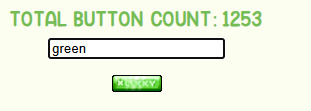

#rentry#rentry graphics#rentry resources#shiny buttons#shiny button#imvu badge#imvu button#imvu buttons#graphics#rentry decor#rentry stuff#bundlrs#stellular#sntry
146 notes
·
View notes
Note
Would it be possible to implement more options for the dashboard? For example, adjusting font sizes and font faces manually on the user end, not just via the themes available by default. I find a lot of people use <small> html tags and the text is too small for me to read, but could easily be fixed if I could bump up the font size for that. On that note, would it be possible to implement more html tags for text posts, like super/subscript, code text (in-line, not for the whole paragraph element), more colors and headings, etc.?
Thank you!
Answer: Hi, @acidcorrodes!
It’s a good question, but it is unlikely that we will be adding these kind of appearance options to the dashboard. That said, we will more than happily point you to some available third-party browser extensions to do the trick instead! For adjusting the font face and font size, for example, you might want to try out Palettes for Tumblr—or, if you’re comfortable writing your own CSS, maybe Stylus would give you the font freedom you’re yearning for.
On that note, would it be possible to implement more html tags for text posts, like super/subscript, code text (in-line, not for the whole paragraph element), more colors and headings, etc.?
It is a fact that there are several of us among Tumblr Staff who would love to see this as much as you. Sadly, this is the kind of thing that would take a full project team to properly implement across our web, Android, and iOS clients—and there are much more pressing issues for our development teams to address at the moment.
We hope this was enlightening! Please do keep the questions coming.
42 notes
·
View notes
Text
Hello fellow FFIV lovers!
In just about a month, on July 19th, we will celebrate the 34th anniversary of that wonderful game. To celebrate, I would like to offer you a little help to get the creative mind running ~
This website will generate for you a Bingo sheet, customized based on selected elements and prompts. With this, you can create a grid of bits of inspiration to use for writing, drawing, anything you can think of! There are characters, places, elements specific to the game, themed prompt, writing or painting challenges...

I offered a few way to play but to celebrate this coming anniversary there's one I particularly have in mind. Creating a 6x6 grid gives you 18 pairs of prompts... Enough to cover from July 1st to the special day ! One day, two square checked, one piece of fanwork, until the grid is filled.
Of course, you don't have to use that. No matter what you make of this website, I would love to see the kind of grid you create and the fanwork that comes out of it!
To hype ourselves for the incoming anniversary, you can tag all your grids and works with #FFIVbirthday2025 !
And watch out for @wordlesslyjenneh's blog as july comes for more FFIV love and hype ~
(Finally: I'm all open to improvement suggestions, additional prompts, ideas... unless it's on the visual end. Don't make me touch more CSS.)
29 notes
·
View notes
Text
Convert HTML to Image: A Step-by-Step Guide ✨
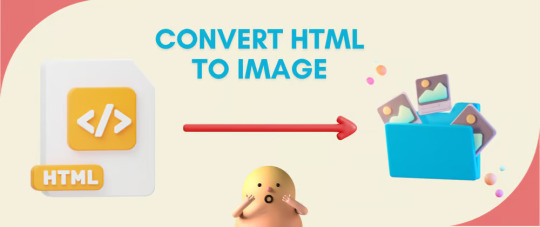
Do you want to turn some HTML code you've made that's on your website and have a way to convert it into an image for you to save?
Well, look no further! I too wanted to do the same thing but funny enough, there weren't any straightforward tutorials out there that could show you how! After hours of searching, I finally discovered the solution~!
This is an old tutorial I made 🐼

💛 Set your environment
Before we dive into the conversion process, I'll assume you already have your HTML code ready. What you want to learn is how to turn it into an image file. You should have a good grasp of HTML and JavaScript. For this tutorial, we'll use the following HTML code example:
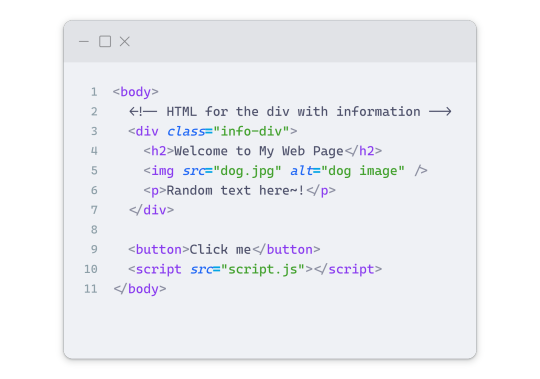
We won't include the CSS code, as it doesn't affect this tutorial. The JavaScript file (script.js) at the bottom of the body element is where we'll add the functionality for the conversion.
Your page should resemble the following:
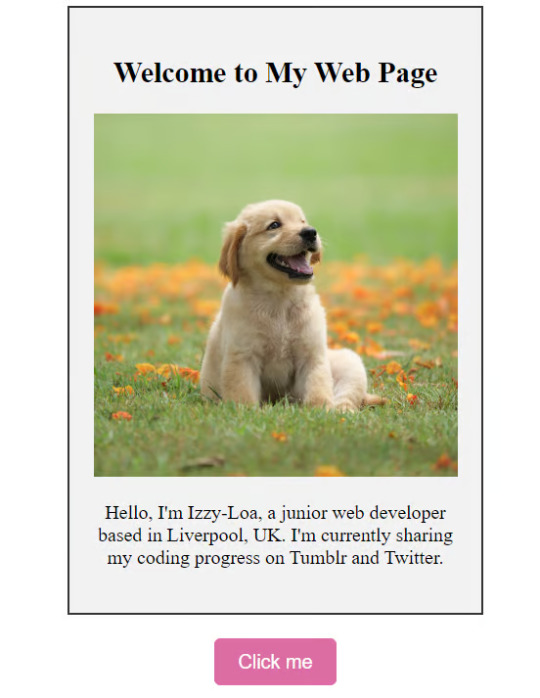
As you can see, the "Click me" button will handle the conversion. We aim to convert everything within the div.info-div into an image.
💛 Using the html2canvas JavaScript Library
The html2canvas library allows you to take screenshots of webpages and target specific elements on a screen. Here are the steps to include the library in your project:
The steps to put the library in your project:
Visit the html2canvas website for more information.
Copy the CDN link from here

and include it in a script tag in your project's head tag in the HTML file:

That's it for including the library on the HTML side. Now, let's move on to the JavaScript code.
💛 JavaScript Functionality
Here's the JavaScript code to handle the conversion:
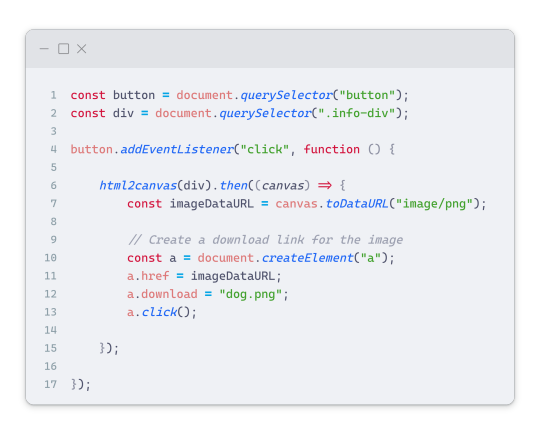
In this code, I want to turn the whole div.info-div into an image, I put it into a variable in const div = document.querySelector(".info-div");.
I also put the button into a variable in const button = document.querySelector("button");
I added a click event listener to the button so when the user clicks the button, it will follow the code inside of the event listener!
You can find similar code like this in the documentation of the html2canvas library:
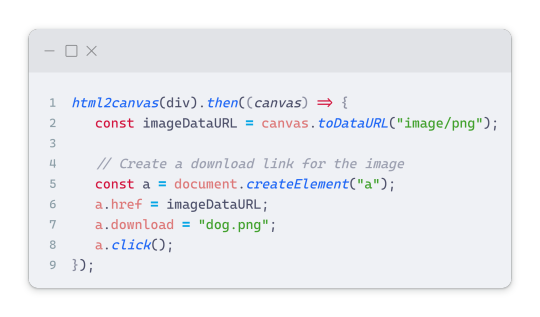
What is happening here is:
We add the div (or what the element we want to take an image of) into the html2canvas([element]).then((canvas)
Added the image file type url to a variable = const imageDataURL = canvas.toDataURL("image/png"); - You can replace the png to other image file types such as jpg, jpeg etc
Created an anchor/link tag, added the href attribute to imageDataURL
The download attribute is where we will give the default name to the image file, I added "dog.png"
Perform the click() function to the anchor tag so it starts to download the image we created
And that's it!
💛 The End
And that's it! You've successfully learned how to turn your HTML into an image. It's a great way to save and share your web content in a unique format.

If you have any questions or need further clarification, please comfortable to ask. Enjoy converting your HTML into images! 💖🐼

#my resources#coding#codeblr#programming#progblr#studying#studyblr#programmer#html#html css#javascript#neocities#coding tips#html5 tutorial#html tutorial
155 notes
·
View notes
Text
Permanent Blacklists for AO3
Would you like to permanently remove fics with your squicks, triggers, and dislikes from all AO3 searches by default so that you never have to think about or encounter them again? Well now you can!
The ability to do this has actually been around for a little while but it relies on some new CSS functionality that wasn't supported on all major browsers until fairly recently (though you may still have to enable it manually on some). I'm not going to explain how this method works or how to code AO3 skins in general, as I've only dabbled in it a little and there are already some very good tutorials out there. If you want all of the details, check out these guides:
Skins and Archive Interface FAQ – The official skins guide created by AO3. Lots of good information but might be overwhelming and confusing for a beginner.
A Non-Extensive Guide on How to Start Creating a Skin for AO3 by ao3skin – Some good, fairly easy to understand, beginner info on CSS and specifically how it applies to AO3 skins.
Permablocking Specific Tags - Site Skin by Eli0t – Everything you need to know to create permablock lists. If your blacklist doesn't seem to be working as expected, check this for troubleshooting tips.
What I can offer though are some handy pre-made blacklists that you can use as-is or as a starting point to create your own so that you don't have to go to the trouble of figuring out how any of this works or hunting down relevant tags. Just copy the code, open AO3, go to My Preferences > Skins > Create Site Skin, paste it in the box, title it, and click Submit!
Note: The following lists are very specific to me and my own personal tastes. Absolutely no judgement if you love any of the things that I choose to blacklist. You do you. I just happen to like my fics fucked up and relatively canonical.
★ No Reader Fic – Hides all self-insert and reader fic.
★ No Alternate Universes – Hides anything tagged with the most common AU tags. There are so many incredibly specific AUs there's no way to list all of them and AU tagging is also extremely inconsistent from fic to fic so this blacklist may only catch 80% of AUs, but that's better than nothing. You could always exclude the entire alternate universe tag, rather than trying to list specific ones, but unfortunately canon divergence and other less extreme AUs would get caught in the crossfire, which is not worth it for me.
★ No Fluff – Hides anything tagged with the most common fluff and romance tags. I specifically left out "fluff and angst" though because sometimes that's used for things that are mostly angst with only a bit of fluff and I do love angst.
★ Bonus: No Dead Dove – This list is not mine (for obvious reasons) but I know some people may find it useful. Hides anything with the main archive warnings and many common problematic, taboo, or controversial tags. Some of these I wouldn't even classify as dead dove, they're literally just kinks, so I'd suggest reviewing the list carefully and removing any that don't apply to you.
Additional Notes:
This system doesn't work exactly the same as AO3's exclusion filters because you can't use top-level wrangled tags to block all subtags. It only blocks exact matches.
Once the blacklist is implemented you'll see no indication that anything was blocked (except for fewer fics listed on each search page); the entire blurb will be hidden. The tags and fic counts listed in the filter bar will remain unchanged. If you want more advanced features like whitelisting or adding something to indicate when a fic was removed, check out the permablocking guide by Eli0t.
Here's a link with info on which browsers currently support the new "has()" element, which this blacklist system relies on. As of right now Firefox for desktop still has to be manually enabled (for instructions see the section on flag enabling in the permablocking guide). Firefox for iOS isn't listed on this website but it seems to work fine for me.
There are other browser-specific extensions that let you permablock tags, such as this one and this one, that may be more a little more user friendly, but I've never tried them so I can't vouch for them and they may not work consistently between different devices. The good thing about doing blacklists via skins is that, after setting it up once, it should work automatically on pretty much any device (as long as you're logged in to your AO3 account).
#I'm so stoked about this feature#it's a GAME CHANGER#I put a lot of effort into creating my blacklists#I couldn't not share them and hopefully make someone's life easier now that I've already done all the work#assuming anyone shares my preferences#ao3#ao3 skins#ao3 help#tutorial#wendy's help desk
387 notes
·
View notes
Note
Your neos skin looks so cool! And I wanted to ask you, if it's okay, how did you the
[fanfic name] by [author]
[fandom(s)]
[rating—relationships—warnings—work status]
going just like that, in three rows? I'm very new to css but I want to patch my own skin from different pieces
Hi! I'm glad you like the previews!
The code to position these elements as shown in the following picture is below the cut.

Edit (23 March 2025): Altered the code slightly so it doesn't mess up blurbs for mystery works.
/* remove the space for the icons on the right side */ .blurb:not(.picture.blurb, .mystery.blurb) .header .heading { margin-left: 0; } /* the following part changes the position of the content icons */ .blurb .header ul.required-tags { display: flex; flex-wrap: wrap; column-gap: 4px; position: unset; width: auto; margin-block: 0.375em; } .blurb .header ul.required-tags li { position: unset; }
5 notes
·
View notes
Text
Instead of doing a Six Sentence Sunday today, I think I'll do a short tutorial on copying over fanfic from FFnet to Ao3.
So you've got some old fics on FFnet and you'd like to back them up to Ao3, given the instability of FFnet. And for whatever reason you don't have the original files for the fics, or maybe you have edits to the FFnet versions that you don't want to lose that the OG files don't have. Whatever the reason, you're looking to directly copy over your fic from FFnet to Ao3. And you're looking for a relatively easy way to do so, but Ao3's import functionality doesn't work with FFnet web pages.
Never fear! It's actually a fairly easy process to get your fic copied over from FFnet.
First, head over to FFnet and open up the fic you want to port over to Ao3. You don't need to log in if you don't want to, just so long as the fic in question is yours and you can access the page, then you're good.
In a separate tab, open Ao3 and login, then choose the option for posting a new work.
Now back on the FFnet tab, you should be able to directly copy over the title, summary, fandom, and what little tagging was available on that site onto the relevant Ao3 fields in the tab you have for a new fic. You'll also want to take note of the published date on FFnet and back date the new work in the Ao3 tab.

FFnet may not have a lot of useful tag data, but it's pretty easy to replicate and build off that in Ao3.
Now for the hard part. Which is still pretty easy. Getting the fic body, plus any notes in the fic itself, copied over to FFnet.
While getting around FFnet's lockdown on the text of the fics they host is fairly simple - I'm pretty sure it's entirely css based - you don't really need to do that in order to get the body of your fic copied. And, honestly, even if you do have a work around in place to allow copying of the fic's text... you will probably find the following method a lot easier still.
In the body of the fic, right click the first line of the fic, which should bring up a menu with a bunch of options. On Firefox or Chrome you want the inspect option.

This'll bring up the dev tools with the html inspection tab open and, if you give it a few seconds to load, the specific line you right clicked to inspect should become the visibly selected section of the html.
The selected section of the html should be a paragraph (or <p>) element. You're going to want to right click the div (<div>) element that encapsulates that paragraph and the rest of the paragraphs in the fic body. This'll bring up another browser menu with the option to copy, which will bring up a flyout menu when you select it. From that flyout menu, you want the select the option for Inner HTML.

You have officially copied the html for the fic body. And you can dump that entirely in html format straight into Ao3's html work text editor. Then switch it to rich text for easier editing if you want to fix any spelling, grammar, formatting, or aesthetic issues. I typically try to fix at least the line breaks since it took a long while before FFnet adopted real line breaks and so there are a lot of fics where I have various combinations of dashes, em-dashes, equals signs, and other characters as line breaks. I figure, if I'm bringing the fic to Ao3 then I can try to make it more screen reader friendly in the process.
You can also move fic notes around in order to move pre/post fic notes out of the fic body or basically whatever you want to the fic. Maybe re-read it to determine any additional tagging you want to add now that your fic has access to Ao3's much more robust tagging system.
But that's it. You can hit post and have your fic with all it's original notes, and a back dated post date to reflect when it was actually written, all available on Ao3 now.
It's a pretty quick process, all told, and the only real bottleneck you might encounter is any time spent in re-editing the fic between migrating and posting. Even chaptered fics are fairly easy to migrate with this process, since the bulk of the work in publishing a new chapter is just copying the inner html and then moving any notes to the appropriate location before hitting post.
Anyway, for my fellow fic writers looking to move your old FFnet fics to a more stable archive, I hope this process helps a lot.
#kitkatt0430 rambles#fanfiction archiving#migrating from fanfiction.net to ao3#ao3#ffnet#fanfiction.net#tutorial
13 notes
·
View notes
Text
Dramione Site Skin
Dramione Site Skin https://ift.tt/nbkxaqV by Aryanwen This is a site skin for Dramione lovers (and not only – you can easily tweak the Dramione elements) that I created for myself over a year ago. THIS IS NOT A FIC!!! Words: 464, Chapters: 1/1, Language: English Fandoms: No Fandom Rating: General Audiences Warnings: No Archive Warnings Apply Categories: Gen Relationships: Hermione Granger/Draco Malfoy Additional Tags: Site Skins, ao3 skin, CSS, dramione skin, aesthetic, ao3 - Freeform, Embedded Images, For comfortable reading via AO3 works tagged 'Hermione Granger/Draco Malfoy' https://ift.tt/FLkM4xO May 22, 2025 at 10:14PM
3 notes
·
View notes
Text
You know what, I'll bother making this post. It's long overdue.
PSA: Please don't install uBlock Origin rules for Tumblr that use :nth-of-type(), and please remove or fix any you have installed. They can and will hide the wrong things. I'll show you a few alternatives below.
First, an example of how we get here. I've used the uBlock Origin element picker to try to hide the "Get a Domain" sidebar item:
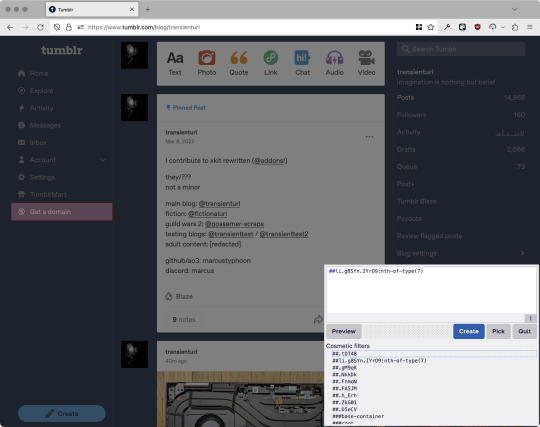
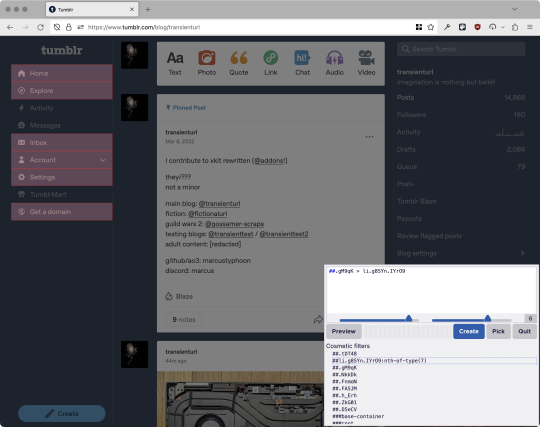
With some different adjustments of the sliders, it gave me these two snippets, one of which targeted a whole bunch of sidebar items, and the other of which selected the right one. Great, right? Read on.
www.tumblr.com##li.g8SYn.IYrO9:nth-of-type(7) www.tumblr.com##.gM9qK > li.g8SYn.IYrO9
As you can see, these both target a particular kind of sidebar item via "li.g8SYn.IYrO9"—fine—and as you can probably guess, the second one counts them all up and hides the seventh it finds.
This is bad, because what it actually hides depends on exactly how many sidebar items there are! Users can "snooze" Tumblr Live, which will make an item appear or disappear, and users with/without Ad-Free subscriptions will have or not have another. I have seen many, many people accidentally hide their activity, messages, inbox, etc using someone else's rule that's supposed to hide Live. Worse, some rules intended for e.g. recommended post carousels that use nth-of-type translate to something like "hide item number three on the dashboard no matter what it is," which will lead to a seemingly random post on your dashboard disappearing!
This isn't a problem specific to Tumblr, of course—I personally think uBlock Origin should never autogenerate these rules—but Tumblr has a ton of elements that aren't in fixed positions, so I feel comfortable wording that PSA the way I did. On a very static site, those rules might be fine. Here they almost always aren't.
So how do we fix this? First of all, as a developer of XKit Rewritten (check out @addons!), I must suggest you check if it has a feature to do what you want. Plenty of times it won't, though, and if not, we want to make a rule that hides an element based on what it is, not where it is. Here are three ways to make a robust rule:
First, I'll right-click the element I want and use the inspect element tool in my browser's developer tools to look at the element I really want (Firefox and Chrome/Edge/Opera have different but overall similar interfaces for this):
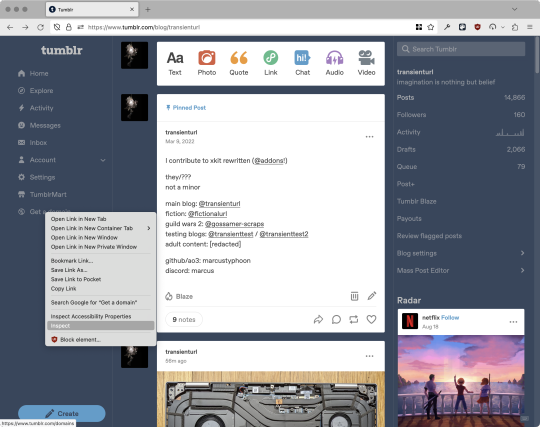
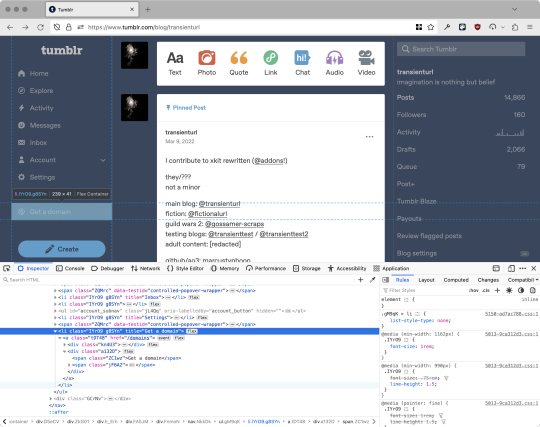
The HTML looks, for reference, like this (Tumblr sucks at code blocks but I'll try):
<li class="IYrO9 g8SYn" title="Get a domain"> <a class="tDT48" href="/domains"> <div class="kn4U3"> <svg> <use href="#managed-icon__earth"></use> </svg> </div> <div class="a132D"> <span class="ZC1wz">Get a domain</span> <!-- other unimportant stuff removed--> </div> </a> </li>
What's something unique about this element, preferably about the outermost element, and preferably contained within the <angle brackets> (HTML tags)? In this case, we have it easy: title="Get a domain" is definitely unambiguous and fulfills all of those three. If you're very familiar with web design using CSS, you'll know how to target that; if you've vaguely heard of CSS, you may be able to look at a reference sheet of CSS selectors, see [attribute=value], and figure it out, and if neither is true, I'll spoil it for you and say that we just put it in square brackets in this case.
So—taking the rule uBlock Origin made, removing the :nth-of-type() and replacing it with our better selector—here's our first working, bug-free uBlock Origin rule:
##li.g8SYn.IYrO9[title="Get a domain"]
Okay, great. But what if we didn't have that attribute to target? What if our top-level element looks the same as the other ones? What if we want this rule to work if we change our Tumblr language to Spanish? Let's move on to :has().
:has() is a CSS selector (supported in uBlock Origin even in browsers where you can't use it for web development yet, i.e. Firefox), that lets you check the contents of an element for whatever is in the parentheses. Let's assume that Tumblr would never make two sidebar items with the same icon, and target that href="#managed-icon__earth" property:
##li.g8SYn.IYrO9:has([href="#managed-icon__earth"])
Yep, that works too!
Finally, what if we couldn't use either of those because we need to target the content of the page that's not contained within the <angle brackets>? We can take a look at the uBlock Origin documentation and find that it has something for that too: :has-text(). You can do very powerful things with this (e.g. you can sort of implement Blacklist entirely using uBlock Origin using something like article:has-text), but it doesn't perform well and can pretty easily be used incorrectly, so I'd suggest you avoid it when possible.
However, let's try using it here to target the "Get a domain" label text:
##li.g8SYn.IYrO9:has-text(Get a domain)
And that also works!
With these techniques, you should be able to target any specific thing you'd want to hide without using any fragile positional selectors. If you're going to share your uBlock Origin rules with others, please make use of this! If you're just using your rules for yourself, then hopefully I've given you enough information so that you can understand what a rule does and decide for yourself if it's worth bothering to fix (menu item order might not change that often, so maybe you're fine with certain rules being a bit prone to breakage; if your rule hides the first post in your timeline you really do need to fix that one!)
-
And, of course, a note for you web developers out there: :has() isn't natively supported in Firefox quite yet, so you can't really use it (I would not recommend using JQuery's simulated version—it's not quite the same). And :has-text() is just not a thing for CSS at all. Just use javascript at that point! Edit: No longer true in 2024; style away!
Final note: any rule with a random 5-character string like g8SYn will eventually break when Tumblr rebuilds its CSS map, though they haven't done that in ages. But when they do: no, it's not "Tumblr devs breaking our rules because they hate us." (Yes, I hear that sentiment a lot in contexts when it almost always makes zero sense.) If you're fairly experienced with CSS you can sometimes make Stylus/uBlock Origin rules that don't reference any, but it's usually convoluted and more trouble than it's worth.
81 notes
·
View notes
Note
Hiya! I found your blog through your neocities website! I was wondering if there’s any tips or things you read/watched that help you make your site. (Im heavily considering making one of my own neocities site it just seems fun)
hihi welcome !! i have quite a few pieces of advice, but the tldr is you should come up with an idea for what you want to make beforehand, and look up how to do each piece! your knowledge will start to fill in along the way :]
(this is probably gonna be long as hell so under the cut is all of the fun stuff /silly)
the way i personally started off was by sketching out what i wanted my site to look like! if you know what you want before you begin, you'll know where to look to figure out what you need to do. html+ css are extremely easy languages to read/write once you know what to look for!
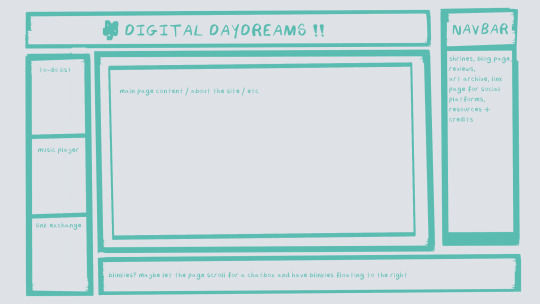
^ this was the original sketch for my site, where i planned out everything i wanted to include. it's a bit different from what actually ended up on the site, but that's alright! it's just about having an outline to work from. i think of it like outlining before you write, it feels like such a pain in the ass because u just wanna start working NOW but u will thank yourself later for taking the time to plan.
once you know what you want to make, start looking for tutorials and resources to make it easier! the grid for my homepage and some of my other subpages was made using a css grid generator, since its one of the more confusing bits of css. you can make grids without it, but its a very easy way to make a more asymmetrical design if ur using the generator!
thats linked here, it gives you some css to put in your head or css sheet, and then the html for the different boxes to slap in your main document. it can be easier to understand what itll look like if you give each one a border while you work, even if its just temporary!
when looking for information about css and html, w3schools is your best friend. its a pretty comprehensive database of every little piece of html + css you could ever need, with examples you can play with yourself to understand what each variable does! it's been a lifesaver for me, ive watched basically zero video tutorials because everything on there is explained so well and you can find basically Anything.
they even have code snippets for things that take more than one or two lines of code, which you can use and adapt yourself! (the tooltips on the official art + my art sections on the hinata shrine were adapted from a tutorial on there!)
in general, having a plan and working from there will make ur life so much easier. the pages that ive sketched out beforehand or ive had a very clear vision for have been WAYY easier to code than the ones i tried to come up with on the fly, and ive been much happier with how they've turned out as well. though i do also have some smaller, rapidfire tips as well that ill go thru now!!
— inline css (the style="" tag) seems so so useful but really should only be used when you're resizing images like buttons. when u keep all of your css in the head or in a seperate document, its way easier to debug and read later. i cleaned up my homepage recently by removing all of the inline css and looking at the code stresses me out WAY less because i can actually read it LOLOL ... plus cutting the css out and putting it in its own document made me realize that id accidentally wrote some really weird code in some places
— this is very much 'do as i say, not as i do,' but use an external editor (like visual studio code) instead of editing live on neocities! you can set up a live preview, and generally wont be pushing out 100 updates every single time you change or add something. i tend to code directly on neocities but its a bad habit and i want to break it eventually v_v
— if you really like an effect someone else has on their site, you can peek using inspect element i promise the coding police won't get you !! dont steal code line for line, but you can figure out what theyre doing and put your own spin on it. things like border images can be really cool, and i only figured out about them because i looked at what someone else was doing and figured out how to adapt it for my own site! check linkbooks and credit sections as well, a lot of people will include links to any effect they didnt make themself or got help with. (including me! the credits section of the linkbook has a ton of little things i got from other places, including a really neat little music player, the rss feed for my status cafe, and the wobbly text on the homepage!)
— most stuff in html and css basically just... says what it does in the tag. so looking stuff up for it is extremely easy! if you've used carrd before you honestly probably already know more abt html than u'd think just intuitively. when ur adjusting the margins or padding in carrd, you're adjusting the margin: and padding: properties in the css of the website it's outputting!
this is getting way too long but!! my best advice is to just get started. you'll never be able to learn without trying, and it genuinely is so fun to have something that's truly your own!
(if u have any specific questions im happy to answer anytime as well! i love talking abt neocities, its a super fun hobby and way easier to pick up than u would think!)
#originals.txt#inbox.txt#neocities.zip#god im so sorry abt how long this is i havent had time to work on the site for a while and its getting to my head /silly
6 notes
·
View notes